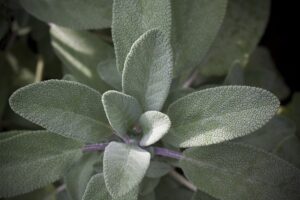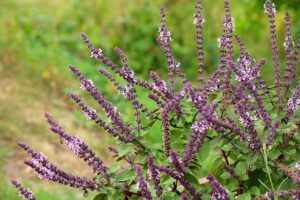
Introduction
Sage, scientifically known as Salvia officinalis, is a perennial, evergreen shrub native to the Mediterranean region. This herb has long been celebrated for its aromatic fragrance, culinary applications, and therapeutic properties. The benefits of sage were held in high esteem across various cultures for its medicinal uses. Ancient Egyptians used it as a fertility drug, while the Romans revered it as a sacred herb. In the Middle Ages, sage was a common ingredient in many therapeutic concoctions and was often grown in monastery gardens for its perceived health benefits. Today, sage continues to be a significant part of traditional medicine, and the potential health benefits of sage are being explored in modern medical research.
This information is meant to be informational and entertaining, not as medical advice. Always consult your medical provider and tell them anything you are taking including herbs. Let them guide you.
Historical Medicinal Properties and Uses of Sage
Historically, sage has been used in medicine for its purported healing and health properties. The Greeks and Romans utilized sage for digestive issues and to heal wounds. It was also thought to protect against evil. During the Middle Ages, sage was a staple in medicinal remedies, believed to cure diseases ranging from mental disorders to infectious diseases. The saying “Why should a man die whilst sage grows in his garden?” emerged during this time, reflecting the high esteem in which the herb was held. Native Americans burned sage in ceremonies for its supposed purifying properties, a practice that continues to this day. Despite these historical uses, it is important to note that scientific research is needed to substantiate these claims and that sage should not be used as a replacement for conventional medical treatment.
Traditional Chinese Medicine Uses of Sage
In the realm of Traditional Chinese Medicine (TCM), sage was highly valued and had unique applications. It was often used in the formulation of herbal mixtures for its warming properties, believed to boost Qi, the vital energy that circulates in the body. Sage was thought to expel coldness, support digestion, and enhance mental clarity. In addition, it was used to address menstrual problems, as it was thought to regulate blood circulation. Again, it’s important to emphasize that these traditional uses are based on TCM concepts and practices, and further scientific research is necessary to validate these uses in the context of modern medicine.
Indigenous Cultures and Their Uses of Sage
Indigenous cultures across the globe have revered sage for its spiritual and medicinal properties. In many Native American tribes, sage is considered sacred and is used extensively in smudging ceremonies. Smudging, a traditional ritual, involves burning sage bundles to cleanse a person or space of negative energy. The smoke is believed to purify the area and promote healing. In the Andean traditions of South America, sage is often paired with other medicinal herbs for spiritual ceremonies, serving as a connector to the divine. Among the Aboriginal people of Australia, sage is used both ceremonially and medicinally, believed to treat digestive problems and skin conditions. It’s important to remember that while these practices are deeply rooted in their respective cultures, scientific research is ongoing to understand the potential health benefits sage may offer.
Modern Medicinal Properties and Uses of Sage
In the realm of modern medicine, sage is recognized for its potential health benefits, backed by scientific research. The herb is rich in antioxidants which are known to protect cells against damage by free radicals. The antimicrobial properties of sage can help in fighting off bacteria and other harmful microbes, making it useful in preventing and treating infections. It’s also used in modern herbal medicine for its positive effect on brain health. Some studies suggest that sage can improve cognitive function and potentially guard against Alzheimer’s disease. Moreover, research indicates that sage may support oral health, with its antimicrobial properties aiding in the prevention of dental plaque. It’s also commonly used in culinary applications for its distinct flavor and aroma. Though the medicinal properties of sage are promising, it’s always recommended to consult healthcare professionals for advice before using it for medicinal purposes. As always, further research is ongoing to fully understand and validate the health benefits of this revered herb.
Current Scientific Understanding of Sage’s Medicinal Properties
At present, scientific understanding of sage’s medicinal properties is primarily based on laboratory studies and animal models. The herb is understood to contain a wealth of active components, including flavonoids, phenolic acids, and essential oils. These components are believed to contribute to its antioxidant, anti-inflammatory, antimicrobial, and cognitive-enhancing effects. For instance, sage’s potential cognitive benefits are theorized to arise from its inhibition of an enzyme known as acetylcholinesterase, which is involved in Alzheimer’s disease. However, it should be noted that the clinical studies involving human participants are limited and further research is necessary to fully establish sage’s therapeutic potential. It is crucial to approach the use of sage for medicinal purposes with an understanding of its current scientific standing. Until more comprehensive human trials are conducted, sage should be considered a supplement to, not a replacement for, traditional medical treatment.

Phytochemical Components of Sage
Sage is rich in diverse phytochemicals that contribute to its therapeutic potential. One such compound is Chlorogenic acid, a potent antioxidant and anti-inflammatory agent that has been studied for its potential benefits in managing conditions like diabetes and cardiovascular disease.
Caffeic acid, another phytochemical found in sage, is known for its robust antioxidant properties that may protect against oxidative stress, a key factor in many chronic diseases.
Rosmarinic acid, found abundantly in sage, is a polyphenolic compound. It’s been studied for its anti-inflammatory, antioxidant, and antimicrobial properties, contributing to sage’s potential as a therapeutic agent.
Ellagic acid is a naturally occurring polyphenol that has been associated with antioxidant, anti-mutagenic, and anti-cancer properties. Its presence is another reason sage is considered beneficial for health.
Finally, Rutin, a flavonoid found in sage, is prized for its antioxidant properties and potential benefits for blood vessel health.
Antimicrobial Effects of Sage
Sage has been traditionally used for its antimicrobial properties, and recent scientific studies back this age-old practice. Its antimicrobial action is largely attributed to its rich phytochemical content, notably rosmarinic acid. This compound has been investigated for its potential to inhibit the growth and proliferation of harmful bacteria, fungi, and viruses. Furthermore, some studies suggest that sage may disrupt biofilm formation, clusters of microorganisms that can exacerbate infections and increase resistance to antibiotics. These antimicrobial properties make sage an interesting subject for ongoing research in the field of natural health solutions. However, it’s important to note that, similar to the therapeutic benefits, more extensive human trials are needed to fully understand and validate the antimicrobial efficacy of sage.
These compounds all play a part in the overall health benefits attributed to sage. However, it must be emphasized that while these phytochemical compounds possess potential health benefits, their effects and interactions within the human body are complex and still under scientific investigation.
Sage and Alzheimer’s Disease

Research has suggested potential benefits of sage in relation to Alzheimer’s disease. Alzheimer’s disease is a neurodegenerative disorder characterized by cognitive decline, memory loss, and impaired functionality. The principal pathological features of Alzheimer’s disease include the accumulation of amyloid-beta plaques and neurofibrillary tangles in the brain.
The antioxidant properties of sage, particularly its rosmarinic acid content, have been investigated for their potential neuroprotective effects. Some studies suggest that sage may inhibit the formation of amyloid-beta plaques, one of the primary markers of Alzheimer’s disease. Furthermore, sage seems to have anti-inflammatory properties which may be beneficial in reducing neuroinflammation, a key element in Alzheimer’s disease progression.
However, it’s crucial to mention that while these findings are promising, they are preliminary. More extensive human trials are necessary to fully understand the potential effects and utility of sage in Alzheimer’s disease management. Therefore, it’s not advisable to use sage as a standalone treatment for Alzheimer’s disease or any other serious health condition without professional medical advice.
https://pubmed.ncbi.nlm.nih.gov/29034191/
https://pubmed.ncbi.nlm.nih.gov/28464779/
https://pubmed.ncbi.nlm.nih.gov/31143299/
https://pubmed.ncbi.nlm.nih.gov/29110743/
https://pubmed.ncbi.nlm.nih.gov/35391712/
Common Uses of Sage in Modern Herbal Medicine
Modern herbal medicine, also known as phytotherapy, continues to utilize sage due to its various potential health benefits. The herb’s antimicrobial properties make it a common ingredient in natural mouthwashes and gargles, aimed at combating oral pathogens and promoting oral health. Additionally, sage’s reputed anti-inflammatory and antioxidant qualities are leveraged in herbal preparations designed to support immune function, detoxification, and overall well-being. Sage tea, made from the leaves of the plant, is traditionally consumed for its purported calming and digestive benefits. As a cognitive enhancer, sage is often found in herbal supplements marketed towards improving memory and mental performance. Despite these uses, sage remains a therapeutic aid within herbal medicine and is not a substitute for professional medical advice or treatment.
Comparison of Historical and Present Uses of Sage
Historically, sage has been renowned for its medicinal properties, with its uses dating back to ancient civilizations. Different cultures have utilized sage in diverse ways, such as using it for spiritual cleansing, treating digestive issues, and even as a natural remedy for snake bites. These historical uses have significantly influenced modern practices, with many traditional uses finding their way into present-day herbal medicine.
Modern herbal medicine often combines traditional knowledge with scientific understanding. For instance, sage’s historical use for digestive issues has been supported by contemporary studies highlighting its potential antimicrobial properties. Similarly, its use for cognitive enhancement, seen in traditional practices, aligns with modern research into its potential effects on Alzheimer’s disease.
Changes in Usage Over Time of Sage
Over time, the use of sage has evolved, driven by scientific advancements and changing cultural practices. While sage was once revered as a panacea, its usage in the modern world is more nuanced. Modern herbal medicine tends to focus on specific applications where sage’s efficacy has been demonstrated, such as digestive complaints and cognitive health. The push towards evidence-based practices has led to a more skeptical and measured approach to its usage. However, the cultural value of sage, traced from historical practices, continues to influence its popularity in herbal medicine today.
Conclusion
In conclusion, sage has played a significant role in medicinal practices, spanning from ancient times to the modern era. Its diverse therapeutic applications, embraced by various cultures, have underpinned its historical significance. This traditional knowledge, when paired with contemporary scientific advancements, has not only validated some of these historical uses but also paved the way for new potential benefits. From digestive aid to cognitive enhancer, sage’s medicinal versatility continues to be a cornerstone in herbal medicine. As we continue to explore and understand its myriad properties, sage remains a symbol of the enduring relevance of herbal medicine in health and wellness.
Note: This content is for informational purposes only and should not be considered medical advice. As always, consult with your healthcare provider before making any changes to your diet.
If you are interested in growing sage chck my article on growing sage.
For more about the medicinal properties of herbs click here.

